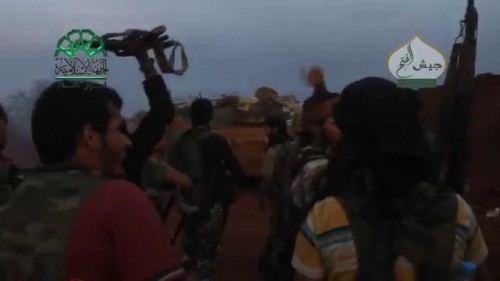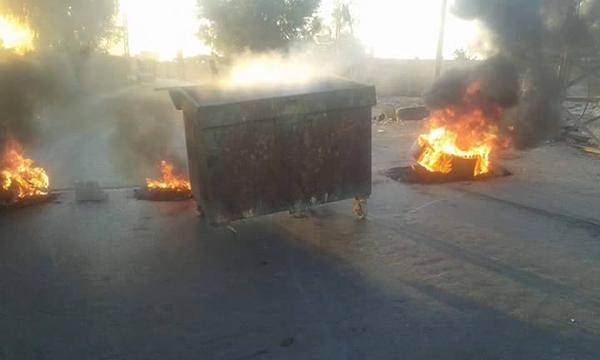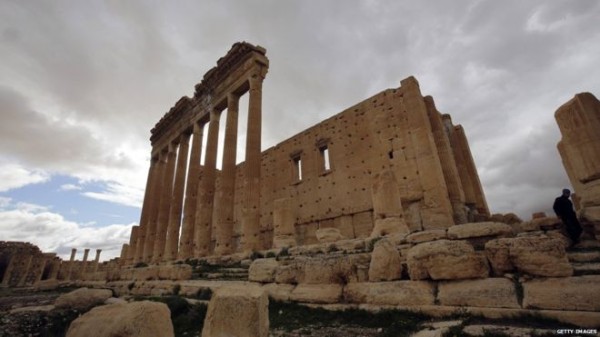PHOTO: Rebels celebrate capture of village near al-Fu’ah and Kafraya in Idlib Province
LATEST
- Video: Free Syrian Army Take Hill in Latakia Mountains
- Report: Islamic State Damages Roman Temple of Bel in Palmyra
- Videos: Regime Airstrikes from Damascus Suburbs to Northwest Syria on Sunday
UPDATE 1500 GMT: Rebels tell journalist Hadi al-Abdallah of their offensive closing on al-Fu’ah and Kafraya and their plans for further operations:
The fighters explain that they took two villages and the al-Kahroda electricity sub-station, while moving into the strategic point of Talat Al Kherba to cut the supply line between the two enclaves.
The capture of the village of Sawagiyeh is another strategic victory because of its agricultural production. In addition to restricting food for al-Fu’ah and Kafraya, the rebel takeover also threatens regime airdrops to the enclaves.
The rebels reiterate that “Iran and the regime sold out Kafraya and al-Fu’ah” when they refused rebel conditions in ceasefire talks: “Their intransigence has led us to control this area….There will be no more negotiations.”
Al-Abdallah assesses that the rebel capture of the enclaves will give them prisoners among the Assad militia, and thus more leverage in the discussions over Zabadani.
(h/t Yalla Souriya)
UPDATE 0915 GMT: Protesters have cut the road to Damascus International Airport this morning with burning tyres and trash bins, calling on the Assad regime to save the regime enclaves in Idlib Province.
ORIGINAL ENTRY: Less than 72 hours after the breakdown of ceasefire talks, rebels are threatening to overrun the last regime enclaves in Idlib Province in northwest Syria.
The rebel coalition Jaish al-Fateh closed on the fortified enclaves of al-Fu’ah and Kafraya on Sunday, taking the nearby village of Sawaghiyeh.
Al-Fu’ah and Kafraya, defended mainly by regime militia, have been surrounded for months. Along with the isolated Abu Duhur airbase, they are the remaining positions of the Syrian military after the rest of Idlib Province fell to rebels this spring.
Rebels have held back from a direct assault on the enclaves because of the extent of defenses and their declining importance in the 4 1/2-year conflict. However, as Hezbollah and the regime have pursued a two-month offensive against Zabadani in Damascus Province, Jaish al-Fatah has launched ground attacks on both al-Fu’ah and Kafraya as well as stepping up a rocket and mortar assault.
Last Thursday, a 48-hour ceasefire was to begin both for the enclaves and Zabadani, allowing the evacuation of elderly and wounded. However, the pause was delayed and then broke down on Friday, with the resumption of fighting and shelling in both areas.
Ahrar al-Sham, representing the rebels in the talks, said Iranian mediators had accepted further conditions such as the release of 1,500 female detainees from regime prisons. However, President Assad and his inner circle rejected the agreement.
Ahrar al-Sham said the Iranians then told them, “Forget freeing your women. Go storm Kafraya and al-Fu’ah.”
The externally-based Syrian National Coalition also criticized the Iranian negotiators, with Vice-President Hisham Marwa asserting:
The Iranian initiative is primarily aimed at emptying the area that links Zabadani with the Lebanese territory to protect Hezbollah strongholds located on the common border between Syria and Lebanon. It also aims to empty Damascus’s perimeter of rebel factions thus enabling the Assad regime tightened its grip on Damascus.
A regime official blamed Turkey for the failed ceasefire, saying it had given orders to Ahrar al-Sham: “One of the reasons that the ceasefire was violated was because Ahrar al-Sham called for complete withdrawal of the Syrian troops from the villages of Kafraya and Fu’ah.”
Messages from rebels in Idlib Province to comrades and residents in Zabadani, just before Sunday’s attacks on the enclaves:
Capture of a regime infantry position near al-Fu’ah:
After the battle in Sawaghiyeh (Warning — Images of bodies):
#Syria #Idlib Fu'ah & Kafraya loyalists pocket situation #Map. Aug 30, 2015 pic.twitter.com/8TCQKCUw9I
— IUCA (@IUCAnalysts) August 30, 2015
Video: Free Syrian Army Take Hill in Latakia Mountains
The Free Syrian Army’s Coastal Brigade capture a hill in the Jabal al-Akrad mountains in Latakia Province:
The battle for the mountains has escalated in recent weeks, as rebels have advanced in the al-Ghab Plain in neighboring Hama Province.
Control of the range would secure the rebel hold on al-Ghab, adding to the possibility of an advance on the Assad heartland of Latakia on the Mediterranean coast.
Report: Islamic State Damages Roman Temple of Bel in Palmyra
The Islamic State has reportedly damaged the Temple of Bel in Palmyra, its second bombing of a Roman-era temple in a week.
An Al Jazeera reporter in the city of Homs was told that the Islamic State detonated more than 30 tons of explosives at Bel, the largest structure in the ancient city.
Local activists supported the report.
The Temple of Bel stands just outside the main area of Palmyra, famed in Roman times as a stop for caravans and travelers.
The Islamic State captured the city in May and threatened to destroy its Roman treasures because they were “idolatry”. Last week, the militants damaged the Temple of Baal Shamin.
A photo of the Temple of Bel before the reported damage:
Videos: Regime Airstrikes from Damascus Suburbs to Northwest Syria on Sunday
As rescuers move follow a regime airstrike on the Damascus suburb of Saqba on Sunday, another bomb lands:
Aftermath of the airstrikes (Warning — Graphic images):
Bombing was reported through the country yesterday from Idlib Province in northwest to areas near the capital in the south. The Local Coordination Committees said 63 people were killed, including 24 near Damascus.
Aerial attacks on Jabal al-Zawiyeh in northwest Syria:



